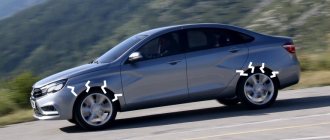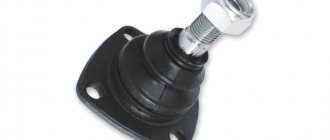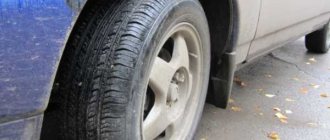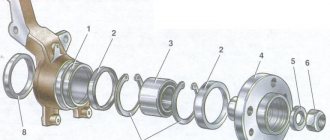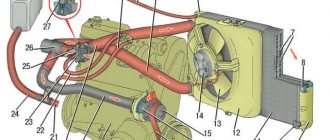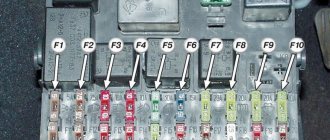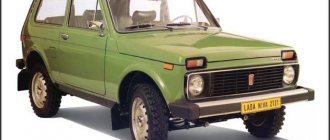Suspension or steering
A knock on small bumps does not always indicate a breakdown in the suspension. Similar sounds may come from the steering. You need to check the suspension and steering rack.
When this mechanism is faulty, vibration on the steering wheel is noticeable when driving on uneven roads. A large gap appears between the rack and gear, increasing over time, and vibration also increases. To get rid of the problem, you need to tighten the rail.
The problem may be related to the bushings on the tie rods. The parts need to be swung individually with a pry bar. If there is significant play, the element should be replaced.
If after tightening the rack and replacing the bushings the problem remains, you need to check the steering joint. For diagnostics, 2 people are needed: one must fix the hinge, body and pin, and the other must turn the steering wheel sharply at a small angle. If there is play, it will become clear that the mechanism requires replacement.
It is worth checking the steering rack ends. A sign of wear - a characteristic sound appears when the steering wheel is rotated while driving at a small angle, play is noticeable. The tips cannot be repaired; only replacement will help.
If the knock remains after the work, a full suspension diagnosis is required.
Front suspension diagram
Causes of knocking in the front suspension
Front suspension knocks on small bumps
The most common causes of quiet knocking noises from the front suspension are:
- Wear of anti-roll bar struts and bushings. The knocking is not dangerous, that is, if you find that it is the stabilizer that is causing it, you can drive, having planned non-urgent repairs in advance, buy parts, arrange at an auto service center, etc.
- Play in the hinges of the steering tips and steering rods. This knock is “more serious” - it all depends on the degree of wear, but it is better to make repairs as soon as possible.
- Wear of the sliding bearing (“cracker”) of the steering rack. Sometimes it is possible to fix it by tightening the adjusting nut, but it is not always possible to do this directly on the car - you have to remove the rack. However, it is often possible to make a homemade wrench by welding a bolt with a suitable hexagon to an extension cord.
- Wear of ball joints - it is their play that often causes a dull knock in the front suspension. If at the same time the car itself “steers” while moving, put it in for repair immediately!
- Play in the front strut support bearing. You can drive by combining its replacement with subsequent repair of the associated components - so as not to disassemble the same thing several times. On some cars (for example, on the “ninth” Mitsubishi Lancer) there is no bearing as such - a bushing is installed instead, but, nevertheless, when it wears out, the knocking noise is quite strong.
Wear of ball joints - it is their play that often causes a dull knock in the front suspension. If at the same time the car itself “steers” while moving, put it in for repair immediately!
In addition to these faults, loud knocking noises can be caused by worn caliper guides and broken front shock absorber bushings - rubber-metal on the bottom and rubber on the top. This “disease” is typical for Zhiguli and Volga suspensions.
“Rubber” squeak in the front suspension when driving
Fastening the front shock absorber strut support
Creaking in the suspension when turning the steering wheel or braking is often caused by “dry” operation of the ball joints.
Often a strong squeak, similar to the squeak of rubber, has nothing to do with it. Creaking in the suspension when turning the steering wheel or braking is very often caused by “dry” operation of the ball joints - due to poor-quality boots, the lubricant is washed out of them.
This creaking noise is more noticeable in dry weather, and its disappearance in the rain confirms this “diagnosis.” You can get rid of it for a while by puncturing the boot and injecting brake fluid or WD-40 with a syringe. But you still have to change the ball joints - even short-term work without lubrication greatly wears out the bearing liner.
The hinges of the stabilizer struts can make exactly the same sound, but this is rather an exception. When driving over a speed bump, the squeak can also be caused by the front strut supports, but it is much quieter than the squeak of the ball joints. You can check the supports by turning the steering wheel from side to side in place - a quiet creaking in the suspension when turning the steering wheel is not particularly scary if the rubber buffer has not been “squeezed out”.
Strong knocking noise in the front suspension
A strong knock in the front suspension when braking or sharply turning at speed is usually caused by a rupture of silent blocks that limit the longitudinal travel of the arms.
The most severe shocks in the front suspension are caused by a leaking shock absorber not working. In this case, the speed of compression and expansion of the spring is not limited - a shock absorber without oil is nothing more than a “decoration”. As a result, instead of a smooth ride, you get a sharp blow - car springs have enormous energy capacity.
A strong knock in the front suspension when braking or sharply turning at speed is usually caused by a rupture of silent blocks that limit the longitudinal travel of the arms. Depending on the type of suspension, such silent blocks can either perform a dual role - work on torsion and compression, or only on compression.
On some cars (for example, Suzuki Jimny), the role of such braces is played by a stabilizer - its ends are attached through silent blocks to the levers, and the middle attachment points are located on the front panel of the body (“TV”). However, the stabilizer itself can play the role of an elastic suspension element, that is, a spring, for example, on a VW Transporter.
Diagnostics of a ball joint by installation
What could be knocking in the front suspension can be easily identified, and the role of a diagnostic tool can be successfully played by a mounting tool or a nail puller.
However, what may be knocking in the front suspension is quite easily identified, and the role of a diagnostic tool can be successfully played by a mounting tool or a nail puller - just insert it between the hinge and any point rigidly fixed to the body and try to press the silent block (or ball, steering end and etc. - by inserting the mounting between the bipod and the hinge body).
A heavily worn unit will immediately “show” play; with experience, even minor wear can be detected. But sometimes the silent block bushing peels off due to defects or improper tightening during assembly - then the play is difficult to identify manually and only a vibration stand will show the fault, or you will accurately guess the moment - by sharply pressing the brake pedal while driving (at low speed possible) and examining the expected place of the knock - sometimes you can see how the lever has moved relative to its axis.
Stabilizer bushings
It is difficult to determine the breakdown of elements by sound. In order not to change the part, you need to check the bushing by hand. This can be done by a mechanic at a service station.
The malfunction can easily be confused with failed silent blocks. The difference is that if the bushings are installed on a subframe, the driver will feel vibration in his legs while driving.
Attention! It is impossible to check and replace the bushings on a lift; you need an inspection hole or platform so that the load is applied to the wheels.
If the parts are faulty, vibration will occur on any bumps.
Stabilizer's pole
The part is used to attach the stabilizer to the suspension. If there is a malfunction, the chassis begins to knock loudly. Knocks can be accompanied by strong car rolls when cornering, during acceleration and braking; it is necessary to constantly steer.
The breakdown occurs due to the anthers becoming unusable, moisture and dirt getting into the mechanism, and wear occurs.
To check the stabilizer links, you need to rock a stationary car. If this happens easily and with a knock, the part is faulty.
Another way to check is to turn the wheel and pull the rods. If there are gaps, it’s time to change the racks. Work should be done on a pit or platform for convenience.
It is important to check the anthers. If the mechanisms are torn, and there is moisture inside and there is no lubrication, it’s time to change the rack.
It is recommended to purchase a new part and replace it.
CV joints are the main instigators of knocking noises during rotation
Often problems are solved by replacing CV joints. This is a rotary mechanism in the external version and an object of independent transmission of torque in the internal version. If before the mystical knocking sound appeared when turning, you did not hear crunching sounds, then the internal CV joint may be to blame. The outer one fails more often, but before failure it begins to crunch when turning. You can check the part as follows:
- put the car in the pit, turn off the speed and turn on the handbrake for easy access to the axle shafts and other suspension elements in the front of the car;
- check for play on the axle shafts by loosening them from top to bottom or in different directions, then check the play by pushing the axle shaft inside the CV joint and back;
- if there is play, the parts have fallen apart, they need to be replaced, you should buy only high-quality spare parts to carry out the necessary repair processes;
- Before replacing, do not forget to drain the oil from the gearbox, since otherwise it will simply flow out through the holes that appear at the site where the CV joints are installed.
The process of replacing internal CV joints is quite complicated. Interestingly, the main reason for parts failure is a torn boot. A part that costs a hundred rubles damages an expensive mechanism that is very difficult to replace. So it is worth monitoring the condition of the anthers and always changing them if necessary.
Checking silent blocks
Car suspensions contain levers whose structure contains silent blocks. Elements are necessary for attaching shock absorbers.
Over time, the part wears out and cannot fulfill its role. “Rolling” appears and the car handles worse. When the silent block becomes unusable, play occurs.
To check the part you need a jack and a pry bar. Necessary:
- Raise the car so that the wheel is hanging out.
- Using a pry bar, loosen the suspension arms, checking for play.
If there is a gap and is accompanied by knocking noises, the part is faulty and needs replacement. It is necessary to check both silent blocks.
Attention! The parts wear out evenly, it is recommended to change them together, even if one does not play.
The process is simple: you need to remove the levers and dismantle the silent blocks. You will need a special tool.
Knocks in the suspension and damping system components
The greatest number of knocks is found in the suspension and damping system. To find a fault, you will need to look under the car - you won’t be able to do it without an inspection hole or a lift.
Knock in silent blocks
First of all, you should check the serviceability of the silent blocks in the car's suspension arms. To do this you will need a flat mount. With its help, you can determine the wear of silent blocks by moving the lever both in the longitudinal and transverse directions. The presence of backlashes, as well as defects in the rubber shell, lead to knocking noises.
Some levers are made in a collapsible version. Then you can replace the silent blocks yourself. To do this, you will have to completely dismantle the lever, and then use a special device with a mandrel to push the silent block out. It is better to lubricate the new part with oil to reduce friction during installation. The inner seating surface of the lever should be cleaned of rust and dirt. Installation of a new silent block is carried out using the same device as dismantling.
Knock in ball joints
A number of control arm suspensions use ball joints that connect the control arm to the hub or shock absorber. To diagnose the source of the knock, you need to hang one side of the car, and then grab the wheel with both hands and shake it left and right. At the same time, you need to observe the behavior of the ball.
To check your suspicions, you can use a pry bar or a powerful flat-head screwdriver. If there is play, the ball joint requires replacement.
You can clearly see how to identify a faulty ball joint in the video at the end of this article.
If bolts and nuts are used as fasteners, the work can be done directly under the machine. When the manufacturer has secured the ball joint to the lever using rivets, the assembly will need to be first dismantled. Using a drill and electric drill, the rivets are removed and new ball rivets are secured with bolts and nuts.
Non-separable levers must be completely replaced. Attempts to convert them into collapsible structures can be costly for the car owner.
Knocking shock absorber struts
The next problem area in the car's suspension is the shock absorber strut. A dull knock in the front suspension may indicate a defect in one of the strut elements.
The simplest diagnostics of shock absorbers is performed by alternately swinging the left or right front part of the car. In this case, the palm of the hand needs to be rested on the top of the rack, which usually goes out in the engine compartment. The driver will immediately feel the presence of knocking noises. We wrote in more detail about ways to check struts in the article on how to check shock absorbers.
A broken support bearing also often makes unpleasant sounds when moving. Its malfunction can be determined visually.
Spherical bearing
The front suspension of passenger cars has 2 ball joints - one for each wheel. signs of malfunction:
- The steering wheel turns harder.
- Knocks are heard in the front suspension when driving.
- Controllability deteriorates, the wheels “float”.
- The rubber tread wears off intensively.
- Wheel alignment is not displayed.
You can determine if the ball joints are faulty by diagnostics: hang the car wheel with a jack or on a lift, hold down the brake pedal, and turn the wheel from the outside. The procedure must be carried out together.
If, during a sharp turn, play appears, accompanied by a knocking sound, an urgent replacement of the ball joints is necessary. The anthers should be checked. The parts must be intact, otherwise they will become unusable.
Causes of knocking in the front suspension
Front suspension knocks on small bumps
The most common causes of quiet knocking noises from the front suspension are:
- Wear of anti-roll bar struts and bushings. The knocking is not dangerous, that is, if you find that it is the stabilizer that is causing it, you can drive, having planned non-urgent repairs in advance, buy parts, arrange at an auto service center, etc.
- Play in the hinges of the steering tips and steering rods. This knock is “more serious” - it all depends on the degree of wear, but it is better to make repairs as soon as possible.
- Wear of the sliding bearing (“cracker”) of the steering rack. Sometimes it is possible to eliminate it by tightening the adjusting nut, but it is not always possible to do this directly on the car - you have to remove the rack. However, it is often possible to make a homemade wrench by welding a bolt with a suitable hexagon to an extension cord.
- Wear of ball joints - it is their play that often causes a dull knock in the front suspension. If at the same time the car itself “steers” while moving, put it in for repair immediately!
- Play in the front strut support bearing. You can drive by combining its replacement with subsequent repair of the associated components - so as not to disassemble the same thing several times. On some cars (for example, on the “ninth” Mitsubishi Lancer) there is no bearing as such - a bushing is installed instead, but, nevertheless, when it wears out, the knocking noise is quite strong.
Wear of ball joints - it is their play that often causes a dull knock in the front suspension. If at the same time the car itself “steers” while moving, put it in for repair immediately!
In addition to these faults, loud knocking noises can be caused by worn caliper guides and broken front shock absorber bushings - rubber-metal on the bottom and rubber on the top. This “disease” is typical for Zhiguli and Volga suspensions.
“Rubber” squeak in the front suspension when driving
Fastening the front shock absorber strut support
Creaking in the suspension when turning the steering wheel or braking is often caused by “dry” operation of the ball joints.
Often a strong squeak, similar to the squeak of rubber, has nothing to do with it. Creaking in the suspension when turning the steering wheel or braking is very often caused by “dry” operation of the ball joints - due to poor-quality boots, the lubricant is washed out of them. This creaking noise is more noticeable in dry weather, and its disappearance in the rain confirms this “diagnosis.” You can get rid of it for a while by puncturing the boot and injecting brake fluid or WD-40 with a syringe. But you still have to change the ball joints - even short-term work without lubrication greatly wears out the bearing liner. The hinges of the stabilizer struts can make exactly the same sound, but this is rather an exception. When driving over a speed bump, the squeak can also be caused by the front strut supports, but it is much quieter than the squeak of the ball joints. You can check the supports by turning the steering wheel from side to side in place - a quiet creaking in the suspension when turning the steering wheel is not particularly scary if the rubber buffer has not been “squeezed out”.
Strong knocking noise in the front suspension
A strong knock in the front suspension when braking or sharply turning at speed is usually caused by a rupture of silent blocks that limit the longitudinal travel of the arms.
The most severe shocks in the front suspension are caused by a leaking shock absorber not working. In this case, the speed of compression and expansion of the spring is not limited - a shock absorber without oil is nothing more than a “decoration”. As a result, instead of a smooth ride, you get a sharp blow - car springs have enormous energy capacity. A strong knock in the front suspension when braking or sharply turning at speed is usually caused by a rupture of silent blocks that limit the longitudinal travel of the arms. Depending on the type of suspension, such silent blocks can either perform a dual role - work on torsion and compression, or only on compression. On some cars (for example, Suzuki Jimny), the role of such braces is played by a stabilizer - its ends are attached through silent blocks to the levers, and the middle attachment points are located on the front panel of the body (“TV”). However, the stabilizer itself can play the role of an elastic suspension element, that is, a spring, for example, on a VW Transporter.
Diagnostics of a ball joint by installation
However, what may be knocking in the front suspension is quite easily identified, and the role of a diagnostic tool can be successfully played by a mounting tool or a nail puller - just insert it between the hinge and any point rigidly fixed to the body and try to press the silent block (or ball, steering end and etc. – by inserting the mounting between the bipod and the hinge body).
A heavily worn unit will immediately “show” play; with experience, even minor wear can be detected. But sometimes the silent block bushing peels off due to defects or improper tightening during assembly - then the play is difficult to identify manually and only a vibration stand will show the fault, or you will accurately guess the moment - by sharply pressing the brake pedal while driving (at low speed possible) and examining the expected place of the knock - sometimes you can see how the lever has moved relative to its axis.
Wheel bearings
The initial stage of breakdown is accompanied by a hum. To make sure that the wheel bearings are faulty, you need to accelerate the car to 50 km/h and perform the “snake” exercise, turning the steering wheel slightly. If you hear a hum, the parts are broken. On which side the sound is stronger, on that side the part is worn out more.
Diagnostics is possible using special equipment, or you can perform the procedure yourself. Necessary:
- Raise the front axle of the car.
- Grab the wheel from above and below with your hands.
- Try tilting.
If the bearing is good, the wheel will be fixed and will not move. The presence of play means the part has become unusable. The problem may arise from the steering rack.
Attention! For vehicles with a front drive axle, the wheels are checked vertically and horizontally.
You cannot continue operating the machine with faulty bearings. The breakdown must be repaired, otherwise the mechanism may suddenly jam.
Signs of bad wheel bearings
Additional noise sources
Let's consider additional sources of extraneous noise!
Steering rack
Failure of the steering rack (especially on the left side) is not a rare occurrence for Renault Logan.
The price for a new steering rack for Renault Logan is very steep
It is necessary to check the serviceability of this element by rocking the lever itself. When it is faulty, a slight play will be felt.
Engine mount
In order to find out the condition of the engine mount, you just need to visually look at it; with a high degree of wear, tears will be visible.
On the left is the old mount, on the right is the new engine mount. The service life of rubber seals is about 100,000 km
In order to conduct such a full, detailed inspection and find a fault on the Renault Logan front suspension, it may require a lot of effort and time. However, when the problem is found and solved, noise when driving on any, even the worst roads, will no longer bother and cause a lot of discomfort to its owner.
Remember that timely repair of even small faults guarantees the durability of the entire suspension as a whole.
Brake problems
If a knocking noise occurs when you press or lower the brake pedal, there is a problem with the ABS (anti-lock braking system). This nuance arises after repair work was performed incorrectly.
Brake problems:
- Damage to the seats for the caliper guides, which is loose and vibrates. Parts need to be replaced.
- Caliper piston jamming. The element hits the pads sharply, causing a knocking sound. The piston changes.
- Brake disc guidance. Due to high temperatures, the part may change shape and bend. The pads begin to wear unevenly. You need to check the disk on special equipment in order to replace it in time.
- The pad retainer has come off and will hit the drum, creating a knocking sound. The part needs to be installed in place and the cause of the jumping off must be determined.
The problem is related to a malfunction in the ABS. It is enough to remove the corresponding fuse from the block. If after carrying out the actions the knocking stops, the ABS is faulty. Specialists can fix the problem; there is no need to try to fix it yourself.
The appearance of faults in the support bearing
The sound from a malfunction in this element is similar to the sound from the development of a damper, but it seems much louder. To detect a breakdown in the bearing, you simply need to remove the strut and inspect the integrity of the element. You will find that it is heavily worn on only one side, because the wear cannot be the same across the entire area of the bearing. The greatest wear is visible when the vehicle is moving smoothly, without any turning.
While driving, it is quite easy to detect problems with the bearing - the knocking noise appears when the car is driving straight, and disappears when the car turns right/left. Also, when the bearing wears out, high vibration is felt when turning the steering column.
Engine support cushions
The pillows contain rubber elements that wear out over time. Because of this, the car rattles when driving.
You need to open the hood and start the engine. Strong vibration indicates that the parts have become unusable. If the engine shakes or tilts more when you press the gas, it's time to change the elements.
You can check the integrity of the pillows yourself without visually. You need to try to shake the power unit. If the action can be performed without effort, it’s time to change the pillows.
You should not ignore such a breakdown; due to the force of vibration, various components are destroyed. When the part becomes unusable, the motor breaks off its mounts, and serious repairs will be required.
You can change the pillows yourself. Without work experience, you should contact the experts.
